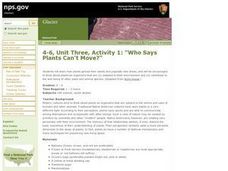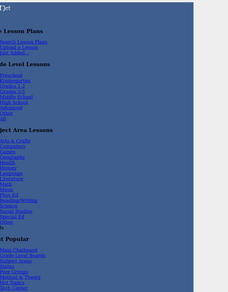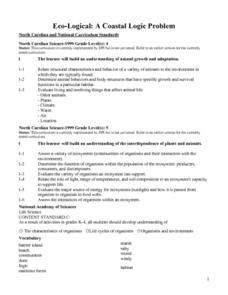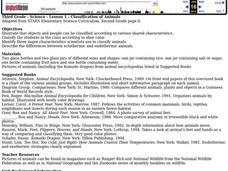Curated OER
Who Says Plants Can't Move?
Students discover how plants spread their seeds using other plants and animals. In this plant instructional activity, students role play different plants and how their seeds travel. Students then have a class discussion to ensure their...
Curated OER
Launching an Inquiry into Endangered Animals
Students create questions they want answered while they show what they comprehend about endangered and extinct species. They categorize photos of living things onto a contunum with the main points for use as a formative assessment.
Curated OER
Eco-Logical: A Coastal Logic Problem
Fourth graders study the characteristics of five coastal communities. They use logic cards and matching activities to identify the proper community for plant and animal species.
Curated OER
A Wild Family Album!
Young scholars create a scrapbook style family album for a selected animal. They complete an interactive Internet activity on research reports, fill out a graphic organizer, diagram a food web, and complete their scrapbook that includes...
Curated OER
Where Do I Go At Night?
Students describe the requirements of daytime and nightime animals for survival. They identify any behaviors that assist in the animal surviving. They create a representation for the class to view.
Curated OER
Charlie and the Cell City
Students investigate the major components of the cell and their function through an adventure inside the cell with an imaginary little guy named "Charlie." Through the use of the Internet and viewing a video, students identify components...
Curated OER
The Game of Life
Learners describe what it means for a marine animal or fish to be threatened or endangered after playing game simulating extinction.
Curated OER
City Animals
Young scholars identify some of the most important native and introduced species of animals in the United States. They describe how animals populations of cities have changed over time, outline the benefits and problems associated with...
Curated OER
The Game of Life
Students explore the game of life which refers to what happens to a species when most of the population is gone. In this endangered species activity, students describe what it means for a marine animal to be endangered. Students then...
Curated OER
Life Cycle: Diversity in a Balance 4th Grade Workbook
In this life cycle workbook, 5th graders examine plant and animal cells, classification of organisms, human biology, photosynthesis, and natural environments. 21 different activities make up the Life Cycle Workbook.
Curated OER
Allosaur Survival Game
Students uses this game to see how difficult survival is even for a fierce predator, especially when it is young. It stresses: How much energy it takes to keep a large animal alive or a small one growing, The differences in the fauna...
Curated OER
Camouflage
First graders learn how plants and animals adapt to their environments. In this camouflage lesson, 1st graders watch a movie that explains animal camouflage, design a butterfly that blends into a classroom habitat, create a mini book...
Curated OER
Habitat Art: Florida Panthers
Students discover the lifestyles of a Florida Panther by investigating its habitat. In this wild animal instructional activity, students utilize the Internet to research the habits of a Panther and what their habitat is. Students...
Curated OER
Variation
In this recognizing categories of plants and animals worksheet, students observe illustrated names of plants and animals and separate them into two groups and then separate them into six groups. Students write 28 short answers.
Curated OER
Animals Active at Night
Students identify animals that are active at night and the reasons why. They examine the features needed to be a nocturnal animal. They create a representation of one of the animals.
Curated OER
Classification of Animals
Third graders practice classiyfying items and identify three major characteristics scientists use to classify animals. They describe the differences between ectothermic and endothermic animals.
Curated OER
Farm Animal Friends
Students apply basic communication and math skills to situations. They apply prior knowledge to list characteristics of different animals. They listen to music to engage multiple senses. Then images of animals are shared with them to...
Curated OER
Classification of Animals
First graders investigate the characteristics of vertebrates. They classify each as mammal, fish, bird, and reptiles. Students explore the differences between various types of animals and classify each.
Curated OER
Native vs. Non-native Species: Who Will Win?
Students examine non-native species and the problems they have caused in the waters of the Chesapeake Bay. They create a "Wanted" poster for one of the species. They describe the effects of non-native species on the schoolyard species.
Curated OER
Taxonomy Project
Students act as a taxonomist and, given a certain situation, classify existing organisms.
Curated OER
Animal clues
Fifth graders use general knowledge to make educated guesses about the habitat and survival strategies of animals from Australia, Antarctica and Africa. They research to confirm and check ideas and group animals in a variety of ways.
Curated OER
The Living Environment
Ninth graders compare and contrast animals according to their four systems. In this living environment instructional activity students complete their assignment on the animal they were given and present their findings to the class.
Curated OER
Classification
Second graders sort insects into groups by determining similar characteristics. They role play as Entomologists to sort insects.

























